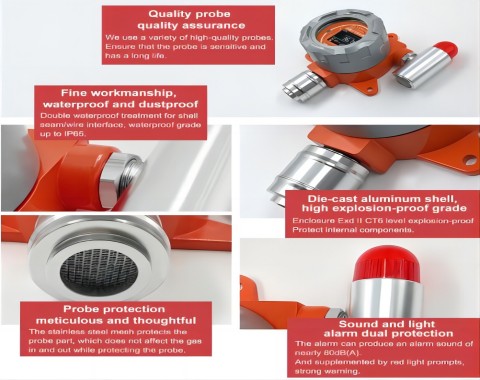The integration of gas sensors with the Internet of Things (IoT) represents a transformative advancement in industrial safety. By enabling real-time monitoring, predictive analytics, and remote management, this synergy addresses critical challenges in hazardous environments. This article explores the technical foundations, applications, benefits, and future directions of IoT-enabled gas sensors, emphasizing their role in mitigating risks and improving operational efficiency.

Keywords: Gas sensors, IoT, industrial safety, real-time monitoring, predictive maintenance
1. Introduction
Industrial environments, particularly those involving chemicals, mining, and manufacturing, are prone to gas-related hazards such as explosions, toxicity, and asphyxiation. Traditional safety measures, such as periodic inspections and manual alarm systems, often fail to prevent accidents due to delayed detection and human error. The advent of IoT technologies has revolutionized this landscape by enabling continuous, automated monitoring of gas concentrations. This article delves into how IoT-integrated gas sensors enhance safety, reduce costs, and drive sustainable industrial practices.
2. Fundamentals of Gas Sensors and IoT Integration
Gas sensors detect specific gases (e.g., CO₂, CH₄, H₂S) through physical or chemical mechanisms. Common types include electrochemical, metal oxide semiconductor (MOS), and catalytic bead sensors. IoT integration involves connecting these sensors to wireless networks (e.g., LoRaWAN, Wi-Fi, Bluetooth) to transmit data to cloud platforms or edge devices. Key components of this ecosystem include:
- Sensors: High-sensitivity, low-power devices with calibration capabilities.
- Communication Protocols: Ensuring reliable data transmission in harsh environments.
- Cloud/Edge Computing: Analyzing data for anomalies and triggering alerts.
- User Interfaces: Mobile apps or dashboards for real-time visualization and control.
3. Applications of IoT-Enabled Gas Sensors
3.1. Mining Industry
Underground mines face risks of methane buildup, leading to explosions. IoT-based sensors continuously monitor gas levels, alerting operators via SMS or app notifications when thresholds are exceeded. Systems like the MineARC Guardian integrate gas sensors with emergency evacuation protocols, enhancing worker safety.
3.2. Chemical Manufacturing
Reactive chemicals like chlorine or ammonia pose toxicity risks. IoT sensors enable predictive maintenance by tracking sensor degradation over time. For instance, a Honeywell Analytics system in a chemical plant detected gradual sensor drift, allowing pre-emptive calibration before failure.
3.3. Oil and Gas Refineries
Hydrogen sulfide (H₂S) leaks are critical in refineries. IoT-enabled sensors with AI-driven analytics predict potential leaks based on historical data. A case study by Emerson Electric showed a 30% reduction in false alarms after integrating IoT sensors with machine learning models.
3.4. Smart Cities and Utilities
Underground utilities like sewers and gas pipelines require monitoring. IoT sensors in Singapore’s Smart Nation initiative detect methane leaks in real-time, reducing environmental risks.
4. Benefits of IoT Integration
4.1. Real-Time Monitoring and Immediate Response
IoT systems provide sub-second alerts, enabling rapid evacuation or shutdown. For example, a Dräger X-am 8000 gas detector integrated with IoT reduced response time in a refinery accident from 15 minutes to 30 seconds.
4.2. Predictive Maintenance and Cost Savings
By analyzing sensor data trends, IoT platforms predict failures, reducing downtime. A Siemens MindSphere implementation in a steel plant saved $2M annually through predictive maintenance.
4.3. Enhanced Compliance and Reporting
Automated data logging meets regulatory standards (e.g., OSHA, EPA). A Honeywell Forge system in a pharmaceutical plant reduced compliance audit time by 40%.
4.4. Scalability and Remote Management
IoT’s cloud-based architecture supports global deployments. A Schneider Electric system in a multinational oil company centralized data from 100+ sites, improving operational consistency.
5. Technical Challenges and Solutions
5.1. Power Efficiency
Battery-powered sensors must last years in remote areas. Solutions include energy harvesting (e.g., solar) and low-power protocols like LoRaWAN.
5.2. Network Reliability
Industrial environments often lack stable connectivity. Mesh networks (e.g., WirelessHART) and edge computing ensure data integrity.
5.3. Data Security
Encrypted communication and secure cloud storage prevent tampering. A Rockwell Automation system used blockchain to verify sensor data authenticity.
5.4. Sensor Calibration
Drift over time affects accuracy. IoT platforms like Azure IoT Hub enable remote calibration, reducing maintenance costs.
6. Case Studies
6.1. Bosch’s Industrial IoT Platform
Integrated gas sensors in a steel plant reduced false alarms by 60% and improved safety compliance.
6.2. Siemens’ MindSphere in Chemical Plants
Predictive analytics detected sensor degradation, avoiding a $5M production loss due to unplanned downtime.
6.3. Dräger’s X-zone 5500 in Mining
Real-time monitoring of methane levels led to a 70% reduction in explosion risks over three years.
7. Future Directions
7.1. AI-Driven Analytics
Machine learning models will predict gas leaks based on environmental data (e.g., temperature, humidity).
7.2. Wearable Gas Sensors
Flexible, low-power sensors embedded in worker uniforms could provide personalized safety alerts.
7.3. 5G Integration
Ultra-low latency networks will enable instant alerts and remote control of industrial equipment.
7.4. Standardization and Interoperability
Industry standards (e.g., ISA100.11a) will ensure seamless integration of multi-vendor sensors.
8. Conclusion
The integration of gas sensors with IoT technologies represents a paradigm shift in industrial safety. By enabling real-time monitoring, predictive analytics, and remote management, this synergy mitigates risks, reduces costs, and improves operational efficiency. Future advancements in AI, 5G, and wearables will further enhance these capabilities, paving the way for safer, more sustainable industrial ecosystems.






